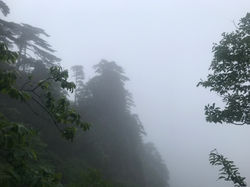Stonehenge Avenue
已更新:2024年10月31日
Stonehenge is a prehistoric temple. The stones are aligned with the movements of the sun.
一個多世紀的堅持
Stonehenge 「巨石陣」的成型,前後經歷了1000 多年,從新石器時代的中期到青銅器時代的初期;在史前 2500 年興建完成。
如果史前人類一生以40年計算,25個世代才將「巨石陣」完成!這是要多麼堅持啊!25個世代共同完成的一項工程,如果寫成一首歌,這會是一首淒美?還是悲壯?的曲調呢!

(Photo Credit | Chi Hsu)
世界遺址

(Photo Credit | Chi Hsu)
1986年 Stonehenge 和附近區域 Avebury,共同被認定為一處世界遺址;漢爺規劃了這趟小旅行時,說:來走一趟史前人類走過的足跡吧!來吧,旅行雙人想像著時空穿越,從 Woodhenge 走到 Stonehenge。(但沿路上,看到的都是牛、馬、羊,和其他英國鄉村健走步道相似,直見到這塊「板」,上寫著 "Stonehenge Avenue"(下圖) )。

(Photo Credit | Chi Hsu)
巨石陣大道| Stonehenge Avenue
當下看到英文的 "Avenue"【註1】的路名時,都會吸口氣,想到紐約的各條大馬路,都是 "Avenue".
可以想見「巨石陣大道」(Stonehenge Avenue)是條重要的樞杻 ,閱讀文獻書上記載,這條大道在史前 2300 年係為要到 River Avon 汲水而興建。

請看著右圖漢爺的手勢延伸,比對著解說板上的圖示,從站立處和遠處的巨石陣連成一線的,就是史前 2,300年興建的「巨石陣大道」!Whoa!這種踩在已空無一物遺址的情緒,和站在紐約曼哈頓第五大道上,盡是琳瑯滿目精品的心情,是一樣的震憾!
從 Woodhenge 走到這兒,終於,這趟「史前人類走過的足跡之旅」,在巨石陣大道上,感受到了最深切的脈動;滿腦子想著,我這一步是踩在距今4,300年前的人類的足跡上,這是他們前往祭天的路上,何其神聖!
我們是何其有幸,在這天地一線的神聖之地,跨越時空,與其共同謝天吧!
【註1】經查,在英國考古學中,Avenue 是個專有名詞來著的,說明如下:(資料來源:維基百科)British Archaeologists refine the general archaeological use of avenue to denote a long, parallel-sided strip of land, measuring up to about 30m in width, open at either end and with edges marked by stone or timber alignments and/or a low earth bank and ditch. The term is used for such features all over the British Isles but they are concentrated in the centre and south of England.
Most are either short and straight (Type I, less than 800m long), or long and curving (Type II, up to 2.5 km). It has been noted that they often link stone circles with rivers. They are a common element to Bronze Ageritual landscapes.
Avenues are identified through their earthworks or using aerial archaeology as their parallel side features can be seen stretching over some distance. In most examples, it is the association of the avenue with other contemporary monuments that provides diagnosis. Avenues differ from cursus monuments, in that the latter also have earthworks at their terminal ends and have no upright stone or timber alignments.
Avenues are thought to have been ceremonial or processional paths and to be of early Bronze Age date. They seem to have been used to indicate the intended route of approach to a particular monument.





